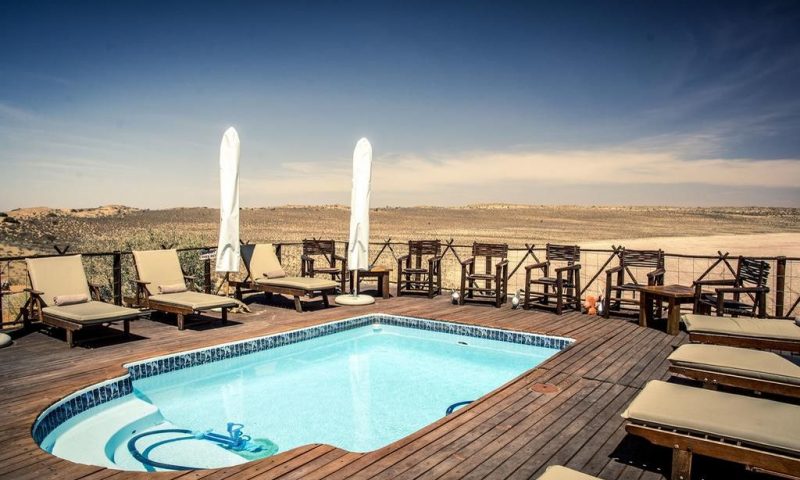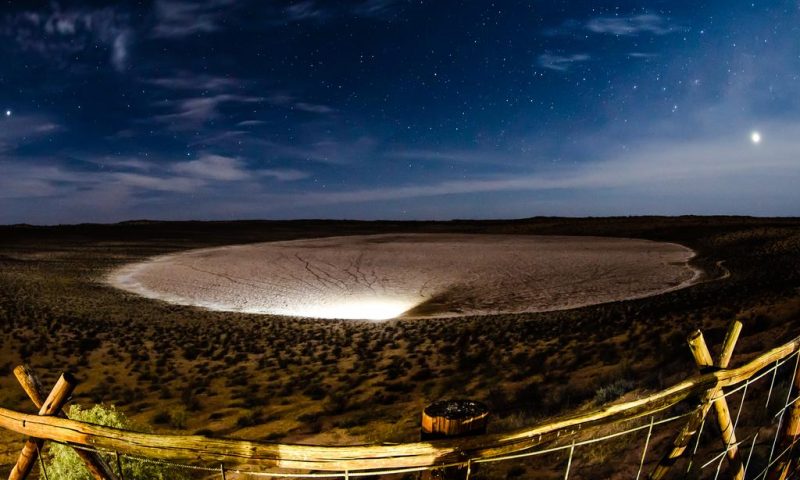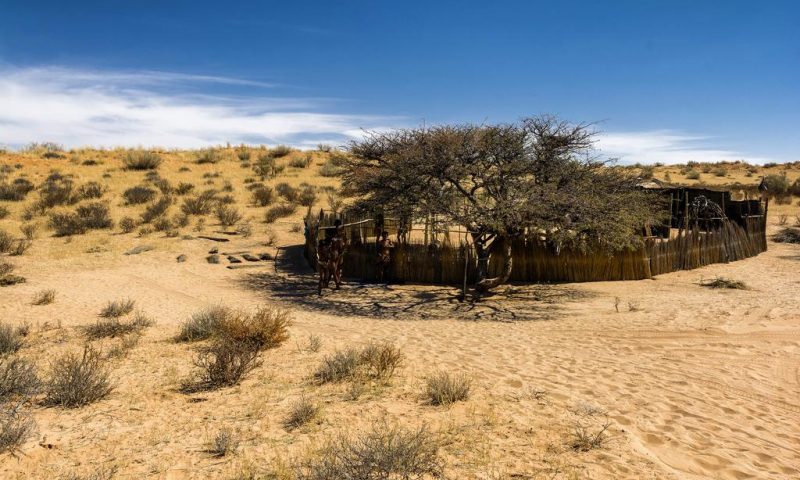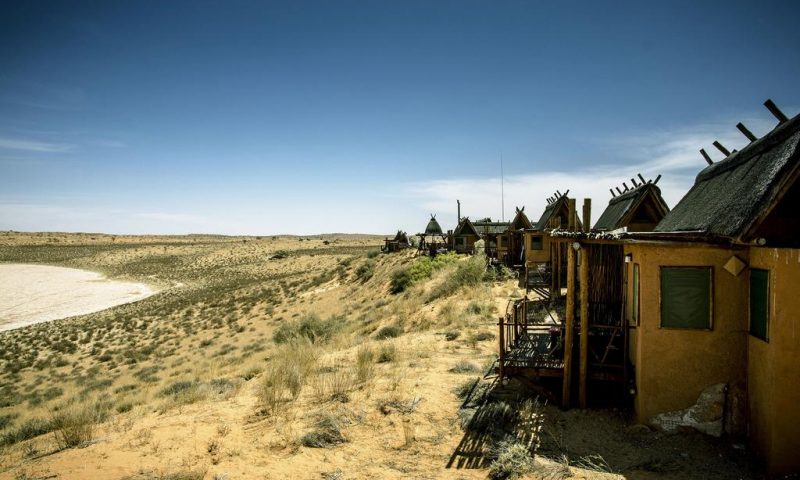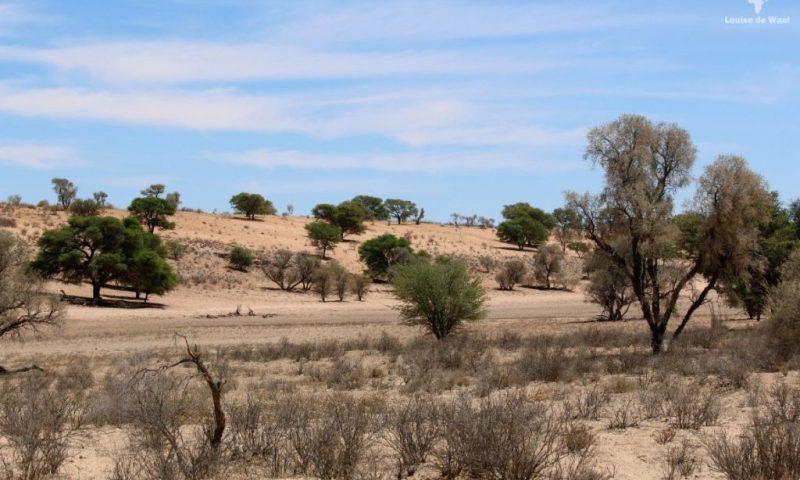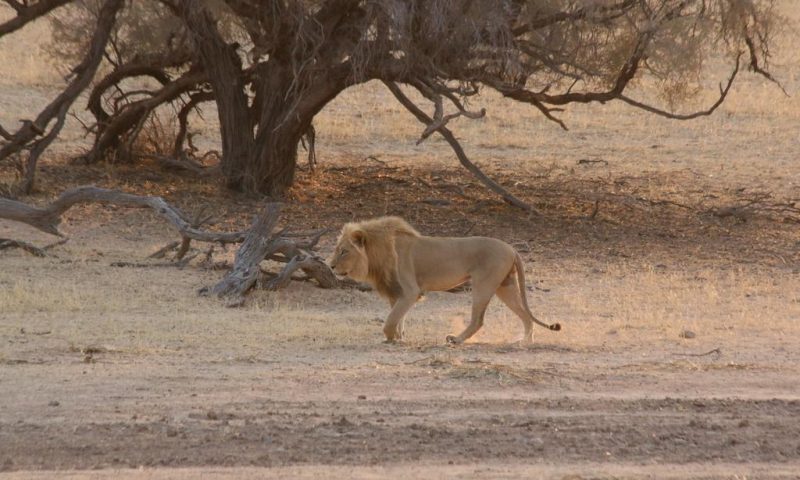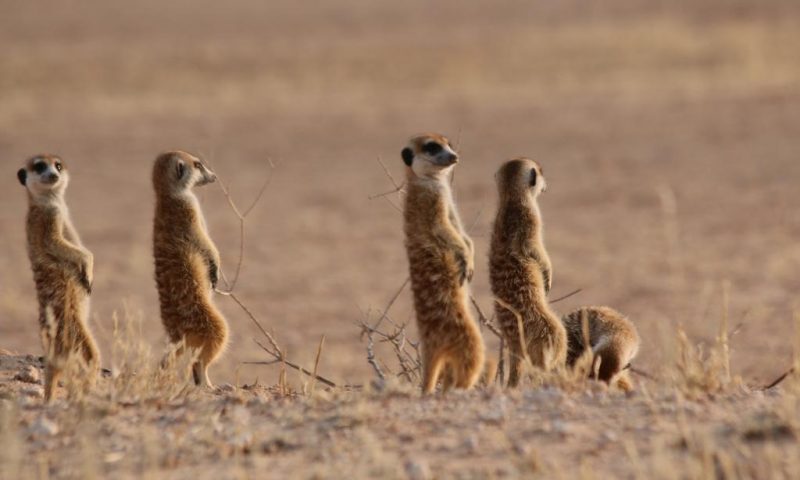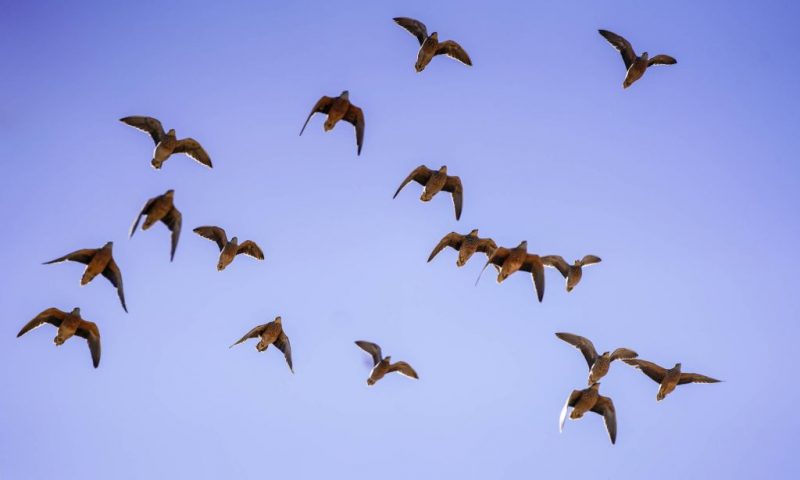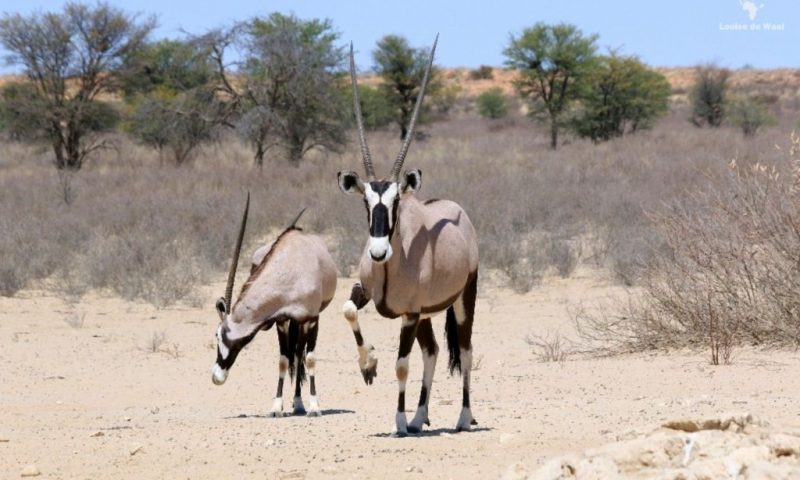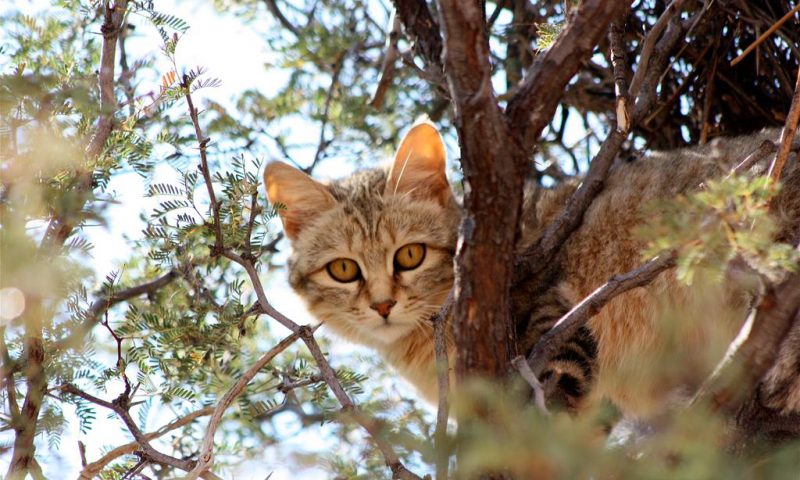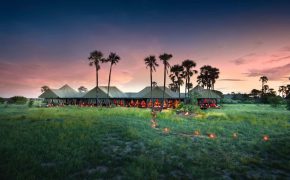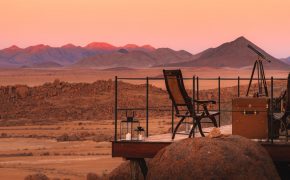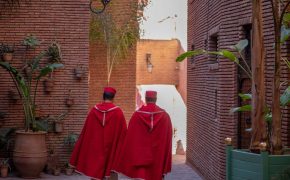Pronounced ‘kaus’, the lodge is a place to experience a unique desert environment, providing accommodation in the Kgalagadi Transfrontier Park for eco-tourists and visitors to this wilderness area in the Kalahari.
A unique living space, highlights of the lodge include a cosy lounge with a fireplace, an art and craft shop, a large observation deck perfect for stargazing, a refreshing swimming pool and a heart- warming fire in the boma, perfect for enjoying the beauty of the silence of the night while keeping warm.
!Xaus Lodge is located in the South African sector of the Kgalagadi Transfrontier Park (KTP) and access is via the Auob River road that connects Tweerivieren with Mata Mata. The lodge is situated 30 km into the desert, reached after driving over 91 sand dunes from the turn-off at Rooibrak waterhole, 60 km northwest of Tweerivieren.
How !Xaus Lodge Began
In May 2002 the ‡Khomani San and Mier communities reached an historic land settlement agreement with the government of South Africa and South African National Parks (SANParks) which restored a large tract of land to the communities that had once roamed or farmed this area.
Named the !Ae!Hai Kalahari Heritage Park Agreement, its outcome resulted in the transfer of ownership of 50 000 hectares of land within the boundaries of Kgalagadi Transfrontier Park (KTP) from SANParks to the two communities who then leased the land back to SANParks.
This land is administered as a Contract Park and remains within the KTP fence line with SANParks retaining responsibility for its environmental management.
The settlement agreement further provided for the communities to receive an allocation of funds for the specific purpose of constructing a tourism facility referred to as a Co-operation Lodge, to be jointly owned by the communities.
Transfrontier Parks Destinations, a black-empowered Lodge Management Company, manages !Xaus Lodge commercially on behalf of the ‡Khomani San and Mier communities.
The name ‘!Xaus Lodge’
!Xaus means ‘heart’ in the Nama language and was proposed as a name for the lodge by a group of visiting Bushmen and confirmed by the representative bodies of both the ‡Khomani San and Mier communities. Significantly, the lodge’s name,
‘!Xaus’, symbolises the healing of relationships, the restoration of dignity and the aspirations of these communities, who after many years of deprivation are now owners of the lodge and the land on which it is situated.
The name was inspired by the fact that the lodge overlooks a large salt pan with a distinctive heart shape in its northwest corner, as well as the fact that the lodge is located at the ‘heart’ – the meeting line – of the land restored to each of the Mier and Bushman communities.
It also symbolises the vision of the settlement agreement which was: ‘in the national interest, to finally settle the land claims of the community parties and to establish a positive, co-operative relationship between the community parties and SANParks.
The symbol ‘!’ denotes a palatal click in the Nama language but for those who can’t master the click, !Xaus is pronounced ‘kaus’.’
The Value of !Xaus Lodge to the Neighbouring Communities
The ‡Khomani San (Bushman) and Mier communities are the owners of !Xaus Lodge and all its furnishings. In addition, the Community representative organisations receive a monthly rental from the operation of the lodge based on its turnover. Almost all the lodge employees are drawn from the local communities where unemployment is rife.
After the first ten years of operation, a ‡Khomani San and Mier Community Trust will be established to receive a 10% equity stake in the lodge management company.
Any asset acquired through donor or grant funding is owned by the lodge and therefore its communities. !Xaus Lodge assists in leveraging donor funding for off-site community health, agricultural, educational and job creation projects.
Kalahari Accommodation at !Xaus Lodge
!Xaus Lodge offers Kalahari accommodation as a game lodge situated in the Kgalagadi Transfrontier Park for eco-tourists and visitors. The complex comprises a central lodge building and 12 individual chalets, each with its own deck overlooking a vast saltpan and waterhole fed with fresh water. One family unit (sleeps 4 people).
This Kalahari game lodge offers a unique living space. The central lodge building consists of a welcoming reception area with its unique wall-hanging made by the ladies of Vezokhule, a sewing co-operative in Upington.
The cosy lounge has a fireplace and a library of selected books for paging through before dinner. Our dining area overlooks the pan, with furniture hand-made in Upington and images burnt by Bushmen artists.
At the art and craft shop, you can purchase locally made Bushman crafts as well as crafts made in the wider Kalahari. Visit the large observation deck from which we gaze in wonder at the night sky, and by day the swimming pool provides cool relief from the desert heat.
Wood is a precious commodity in the Kalahari, so the inviting fire in the boma is made in the traditional method with three or four crossed sticks around which everyone huddles companionably.
In the en-suite chalets we provide purified drinking water from the desert which you will find in a flask in your bathroom. Winter sheets and gas heaters provide comfort for the cold nights, and ceiling fans bring relief in the hot months.
Water
Water is an extremely scarce resource in our environment, any contribution made to using it sparingly is most valued. Read More…
Electricity
The lodge is equipped with a generator. In order to limit the environmental impact, the generator operates between 7 – 10am and 5 – 10pm.
Telecommunications
No cell phone, Wi-Fi or TV signals. Telecommunications signals don’t reach the Lodge. The Lodge and the vehicles have 2-way radio links with SANParks facilities. Satellite phone and email available only in cases of emergencies. Wonderful hours of silence and an opportunity to unwind from day-to-day life, enjoy the digital detox!
Bird Watching
!Xaus Lodge is located in the Kgalagadi Transfrontier Park, an immense desert area, with grass-covered sand dunes. At over 3,5 million hectares, it’s almost twice the size of the Kruger National Park, and is jointly managed by the South African and Botswanan wildlife authorities.
Two hundred and sixty-four species of birds have been recorded in the Park, however the majority of birds are not resident species and are irregular visitors to the Park. Many of the birds cannot survive all year round in the Kalahari and fly to areas where there are more favourable conditions.
Kgalagadi Eagle
Of the species recorded, only 78 are residents, while 16 species are seasonal migrants and 18 are nomads. Two-thirds of the raptor species found in southern Africa can be seen in the Kalahari, while smaller species such as the lilac-breasted roller and swallowtailed bee-eater are also well represented.
Cultural Village
Take a walk to our recreated cultural village and see the Busman crafters at work. You may join young Bushmen demonstrating their traditional games and purchase traditional crafts hanging from the branches of the tree under which the crafters sit at work. These crafters also sell their goods at the Lodge curio shop.
Game Drives in the Kgalagadi Transfrontier Park
Enjoy a fantastic sunset game drive on the pan and an after-dinner drive to explore some of the night creatures the Kalahari has to offer:
- Sunset pan drive and dune walk to ‘listen’ to the sun set over the Kalahari with an early evening game drive back to the lodge.
- After-dinner night drive, with the accompanying sounds of barking geckos, insect shrills, and larger animal calls to break the silence.
A complimentary six to seven hour game drive through the dunes and along the Auob River, with packed breakfast and picnic lunch, is available for guests staying four nights or longer.
At an additional charge, this game drive is also available to those staying for two or three nights. Please discuss the availability and cost of this with our management.
Guided Walks
Set out at day-break with the guides and Bushman trackers to walk through the dunes as you learn all about your natural surroundings. You will be shown how to identify animal spoor, birds, trees and plants, and discuss their medicinal uses.
You’ll return to the Lodge in time for a hearty brunch made by the local Mier ladies. The length of the walk, and distance you cover, depends on the fitness and interest of the guests. A shorter guided walk is also arranged to see the ‘heart’ of the pan.
Stargazing in South Africa at !Xaus Lodge
At night, you see the universe. You may feel like you have never seen the night sky before when you go stargazing at !Xaus Lodge. The Milky Way arcs over you like a giant swathe of smoke – reminiscent of the Bushman tale of its origins.
A girl from an ancient race, the story goes, threw the cinders from a fire into the sky to light hunters’ paths home. Prominent all through the year are the Southern Cross, Carina, and Centaurus. Hundreds of other stars and constellations nearly leap out of the blackness.
The !Ae!Hai Kalahari Heritage Park that surrounds !Xaus Lodge is one of the world’s darkest places and offers some of the best star gazing in South Africa. It was named an International Dark Sky Sanctuary by the International Dark Sky Association in April 2019.
Night really falls there, nearly totally free from pollution, including light pollution, natural atmospheric pollution and man-made pollution. On the SQM (or Sky Quality Meter) scale of darkness, with 22 being as unadulteratedly dark as you can get, !Xaus Lodge and environs measure 21.9.
“!Xaus Lodge is a special place to observe the night sky for a number of reasons,” says Dr Vincent Joseph, an avid amateur astronomer who assisted in getting the International Dark-Sky Association Sanctuary status confirmed.
“Light pollution is easily controlled at !Xaus Lodge,” Joseph says. “We are actively incorporating a policy that will reduce the pollution to a minimum and allow for ideal sky-viewing conditions.
We were awarded the International Dark-Sky Sanctuary status due to our exceptional conservation of the night sky in the !Ae!Hai Heritage Park, especially with regards to !Xaus Lodge. Being the only lodge in the !Ae!Hai Heritage Park, !Xaus Lodge is now a preferred viewing sight of Dark Sky enthusiasts.
“Natural atmospheric pollution is reduced there as the lodge has limited rain clouds/storms,” he adds. “Plus being at an altitude of 930 m, !Xaus Lodge is already elevated in the atmosphere, thus reducing atmospheric disturbance.
“Since !Xaus Lodge is located in a remote desert, there is no pollution from domestic or industrial smoke or fumes from traffic. And since the horizons are open and uncluttered with buildings, night-sky observations are easier.”
The Milky Way – our own galaxy – most impresses stargazers at !Xaus Lodge. “On a moonless night it is so bright that one can use it to walk unaided in the desert,” Joseph says. Like the hunters of old.
Aside from the planets, constellations and associated stars in our own galaxy, Joseph says, there is great interest in objects outside our galaxy in ‘Deep Space’.
“During the early 1900s, astronomers were unaware that there were other galaxies outside our own Milky Way,” Joseph says. “When they saw a small fuzzy patch in the sky through their telescopes, they called them ‘nebulae.’
“Edwin Hubble discovered that these nebulae were not nebulae at all, but other communities of billions of stars held together by gravity – galaxies! Suddenly, our universe was much bigger. We realised that our galaxy was just one of many billions of galaxies in the universe, each one having millions/billions of stars within it.”
There’s never a time not to stargaze at !Xaus Lodge, though moonless nights are preferable. Aside from the year-round constellations, the calendar of most impressive constellations visible from !Xaus Lodge runs as follows:
- Southern Spring Constellations: Andromeda, Aquarius, Pegasus, Pisces
- Southern Summer Constellations: Canis Major, Gemini, Orion, Taurus
- Southern Autumn Constellations: Bootes, Cancer, Leo, Virgo* Southern Winter Constellations: Aquila, Cygnus, Sagittarius, Scorpius
The best way to appreciate the sky at !Xaus Lodge is in the company of local people, whose indigenous knowledge and traditional skylore reflect a reverence for the sky and everything in it.
To many Bushmen, particularly, the sky is a spiritual realm, and the stars are human and animal kindred spirits – either departed from this world or yet to arrive. The tale of how the sun was once a man from whose armpit shone rays of light.
He lived in a hut and kept the light to himself. Children were sent to throw the sleeping sun up into the sky, where he now shines, except at night when he draws an old blanket over himself to stay warm. The stars are the holes in his blanket.
Or a tale of the Moon – according to Bushmen legend, actually an old shoe that Mantis threw up into the sky to guide himself. As it rises it is red with desert dust and just as cold as old leather.
Standing outside on !Xaus Lodge’s elevated decks, in the dark silence penetrated only by the clicks of barking geckos, or perhaps a distant lion’s moan, you can look into infinity in the sky overhead, and perhaps imagine also what the Bushmen believed: their shamans, once in trance, would climb invisible cords stretching skywards to consort with the ancestors.
The Kgalagadi Transfrontier Park
The Kgalagadi Transfrontier Park is an immense desert area, with grass-covered sand dunes. Formally known as the Kalahari Gemsbok National Park on the South African side and the Gemsbok National Park in Botswana, it existed as a single ecological unit and the international border between the two countries.
At over 3,5 million hectares, it’s almost twice the size of the Kruger National Park (and about the same size as the Netherlands), and is jointly managed by the South African and Botwsanan wildlife authorities.
A constant high pressure cell forms a ‘lid’ over the interior, preventing moist air from the ocean reaching the area, and as a consequence the long-term rainfall average is just 213mm per annum, which classifies the Kgalagadi as a true desert.
Unusually, there is an abundance of desert grasses, giving the landscape an appearance of a semi-desert.
The Kalahari Red Dune Route
Just north of Upington, the Red Dune Route winds through the Kalahari and into the Kgalagadi Transfrontier Park. The ancient and beautiful land is home to endless landscapes, vast openness and a rich diversity of encounters and experiences.
The Red Dune Route drifts from guest house to game farm across a pleasurable combination of welcoming hospitality and spectacular scenery.
Some of the many reasons to visit is the wide range of activities available including desert walks, dune-boarding, 4×4 trailing for the adventurous, game drives, guided walks, birding expeditions and other eco-inclined activities for nature-lovers.
For visitors attuned to culture and history, the Kalahari Red Dune Route offers the opportunity to experience regional customs and folklore, sample traditional cuisine, and meet the warm and welcoming people of the Kalahari.
Journey with us and discover a destination that is rich in history and culture – embracing one of the oldest people groups on the planet, the Khomani San (amongst others who call this place home).
Kgalagadi weather
The rainfall, usually in the form of dramatic thunderstorms, falls between November and April. The temperatures in the area vary from -11°C on cold winter nights to a sweltering 42°C in the shade on a summer’s day.
Our winter, from May to August is generally cool and dry. In spring, from September to October, the climate is also dry, but warming up in preparation for our summer which, along with autumn, brings the rainfall combined with high temperatures from November to April.
The Kgalagadi Transfrontier Park is characterised by two dry riverbeds that flow through the heart of the game reserve: Auob and Nossop, and the main roads – and game viewing sites – are concentrated along these rivers.
As with all deserts around the world, the freedom to move to where water and grazing is available is central to the park’s ecosystem. Thus in winter (when it is dryer and colder) the antelope herds tend to move further north where the savannah vegetation is less susceptible to frost.
Predators in turn move into the dune areas where it’s slightly warmer. Conversely, during summer the antelope herds congregate in the dry river beds, and it’s not uncommon to see a thousand head of springbok at a time, standing still in the available shade. In turn, the predators also return to the river areas where there is good hunting
Wildlife sightings in the Kgalagadi
The Kgalagadi Transfrontier Park has only 8 antelope species, but 19 carnivores, including the famous black-maned lion. These lions have adapted to the extreme conditions, and kill a far higher proportion of small game than lions in other parts of Africa.
They walk an average of 12km per night in search of food. The Kgalagadi has about 300 bird species of which only 82 are resident. Raptors are common, and highly visible in the arid vegetation.
